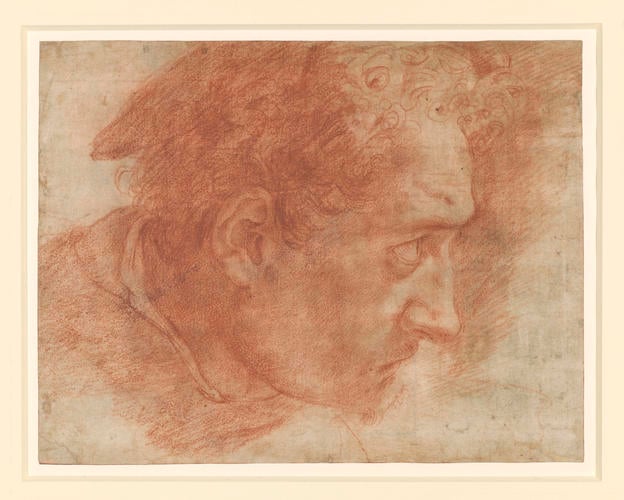The head of St Thomas(?) c.1527
Red chalk. Verso: Black chalk and wash. | 20.9 x 26.8 cm (sheet of paper) | RCIN 901888

Polidoro da Caravaggio (c.1499-c.1543)
The head of St Thomas (?) c.1527


-
The figure has a halo and looks up with an expression of trepidation; he might be St Thomas at the moment at which Christ showed his wound to the incredulous Disciple after the Resurrection. Polidoro executed a painting of that subject around 1530 (now in the Courtauld Institute Galleries), but the saint there is quite different in appearance. An alternative suggestion is an association with Polidoro’s painting of Sant’Angelo Crowned by Angels (private collection, Rome), close in date to the St Thomas (P. Leone de Castris, Polidoro da Caravaggio, 2001, p. 492). The profile is indeed similar, but the saint in that painting tilts his head back to look up at his crown, and it is unlikely that the hesitant face of the figure in this drawing could have been intended for a saint gazing heavenwards.
The drawing was classed in the eighteenth century among those by the Carracci, but M. Clayton (note on old mount, 2000) recognised Polidoro's authorship: it is indeed one of the finest red-chalk life study by the artist. A date before Polidoro’s Sicilian period is suggested by the studies on the verso of the sheet. The two larger drawings of a figure holding what appears to be an X-shaped cross - uncovered in conservation in 2003 - are probably studies for St Andrew in an altarpiece that Polidoro executed for the fish-merchants in Naples (see also RCIN 990383). In 1526 their votive chapel was rebuilt as the church of Santa Maria delle Grazie alla Pescheria, altered many times over the centuries before its demolition as recently as 1968. Shortly after his arrival in Naples in 1527, in flight from the Sack of Rome, Polidoro received the commission to incorporate a miraculous panel of the Madonna and Child from the old chapel into a new altarpiece for the church. He initially planned to house the panel within a single-field altarpiece depicting angels supporting the frame of the panel, above souls in purgatory flanked by the patron saints of fishermen, Peter and Andrew (this design is recorded in another drawing in the Royal Collection). But the altarpiece was executed as an assemblage of smaller panels clustered around the votive Madonna, and all Polidoro’s subsequent studies for the project (including several for St Andrew) treat the elements individually. Some panels were removed at an early date, and on the destruction of the church the remaining parts of the altarpiece were dispersed. The panels of St Peter and St Andrew are now on deposit in Capodimonte, Naples.
The other small study on the verso of the sheet shows Tobias and the Angel, a typical Polidoro sketch of small-scale, quirkily proportioned figures but executed in an unusual technique of black chalk and wash. It has not been possible to relate this study to any other work by the artist.
Provenance
First recorded in George III's 'Inventory A' of c.1810, p. 74, Caracci Tom. 3, among '14 Various Studies of Heads of the three Caracci'.
-
Creator(s)
Previously attributed to the school of (artist) -
Medium and techniques
Red chalk. Verso: Black chalk and wash.
Measurements
20.9 x 26.8 cm (sheet of paper)
Object type(s)








